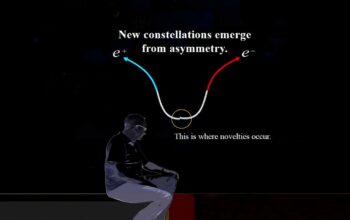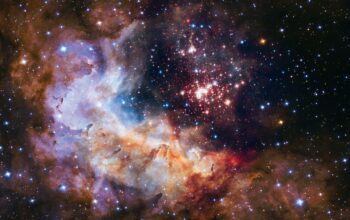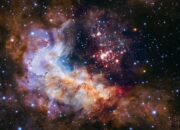The Atacama Large Millimeter/submillimeter Array (ALMA) has emerged as a pivotal instrument for elucidating the intricate processes governing cosmic chemistry, particularly in the wake of supernovae. This revolutionary array of antennae, nestled high in the Chilean Andes, provides unprecedented insight into the molecular dynamics that unfold following the catastrophic demise of massive stars. By meticulously examining the remnants of supernovae, ALMA reveals not only the composition of the interstellar medium but also the mechanisms that facilitate the synthesis of complex molecules necessary for the emergence of life as we know it.
As supernovae explode, they disseminate a cocktail of elements throughout the cosmos. These cataclysmic events function as nucleosynthesis factories, creating heavy elements via rapid neutron capture processes and dispersing them across the galaxy. The elemental diversity synthesized in such stellar explosions contributes to the enrichment of the interstellar medium, where gaseous clouds may subsequently collapse to form new stars, planets, and ultimately life. The fascinating interplay of physical and chemical processes illuminated by ALMA allows astrophysicists to probe the correlation between stellar death and chemical evolution in the universe.
ALMA’s capabilities extend beyond mere element detection; it can discern specific molecular transitions within the aftermath of supernovae. This capability is crucial, for it enables scientists to unravel the enigmatic pathways of molecular formation. In particular, ALMA has been instrumental in the identification of complex organic molecules, such as methanol and even more complex hydrocarbons, in supernova remnants. By capturing the millimeter and submillimeter emissions from these molecules, ALMA fosters a comprehensive understanding of the ephemeral and intricate chemistry occurring in post-explosion environments.
The detection of molecular species in supernova remnants raises profound questions about the origins of organic life. The theory of panspermia postulates that life, or at least the precursors of life, may be distributed throughout the universe via comets, asteroids, and interstellar dust. Supernovae could serve as crucial agents of this process, catalyzing the formation of organic molecules that then travel between planetary systems. ALMA’s ability to identify these molecules enhances our comprehension of the possible chemical pathways that may lead to life-supporting conditions on exoplanets, especially those located in the habitable zones of their stars.
One illustrative case study involves the remnants of Supernova 1987A. Observations conducted with ALMA have yielded compelling evidence for the presence of dust that is rich in carbon compounds. This organic dust forms as matter cools and coalesces following the explosive event. The study of such dust not only contributes to the understanding of cosmic dust formation but also invites speculation about the potential for habitable conditions in the vicinity of such remnants. As dust is critical for the formation of planetary systems, the presence of carbon-rich materials suggests that supernovae may be intrinsically linked to the emergence of planets capable of hosting life.
Moreover, the significance of ALMA’s findings extends to the broader framework of galactic evolution. The intricate chemistry evinced in the aftermath of supernovae informs models of star formation, as the enrichment of the interstellar medium plays a crucial role in the birth of future stellar generations. A galaxy’s chemical history, shaped significantly by its supernova activity, catalyzes the evolution of star systems over cosmic timescales. The data retrieved from ALMA contributes to a nuanced understanding of this interplay, allowing cosmologists to endeavor deeper into the enigma of galaxy formation and evolution.
ALMA’s contributions to the field also highlight the synergistic relationship between observational astrophysics and theoretical modeling. As new data regarding chemical compositions arise, models can be refined to more accurately depict the complex interactions governing molecular processes. The dynamism of cosmic chemistry demands that scientists remain agile and adaptive in their theoretical frameworks, integrating new observationally-derived insights as they unfold. This mutual reciprocity between observation and theory exemplifies the essence of scientific inquiry: an iterative process whereby hypotheses are continually tested and adjusted in light of novel findings.
The astonishing capabilities of ALMA offer a paradigm shift in our understanding of the cosmic tapestry. The insights gleaned from the aftermath of supernovae herald potential transformative revelations in both astrophysics and astrobiology. The intrinsic connection between stellar evolution and molecular chemistry invites a reevaluation of our position in the universe and our understanding of life’s origins. As our investigative lens broadens through the lens of ALMA, the pursuit of knowledge will inevitably lead to new opportunities for inquiry, discovery, and a deeper appreciation of the universe’s grandeur.
In summary, ALMA’s detection of cosmic chemistry in supernova remnants is not merely an academic endeavor; it is an invitation to embrace the complexity and interconnectedness of the universe. As scientists delve deeper into this compelling domain, they tease apart the threads of cosmic evolution, revealing stories that transcend individual stars and their life cycles. The ramifications of these discoveries extend far beyond the cosmos, influencing our perception of life, evolution, and our place in the grand narrative of the universe.












